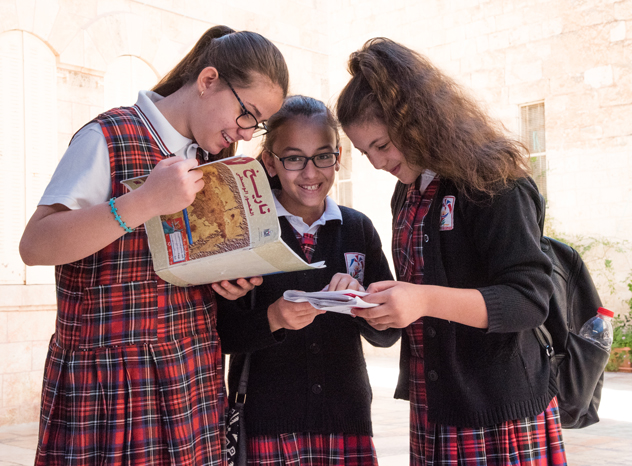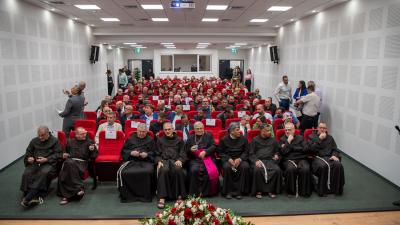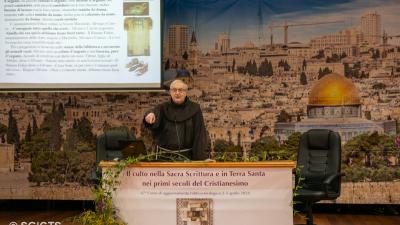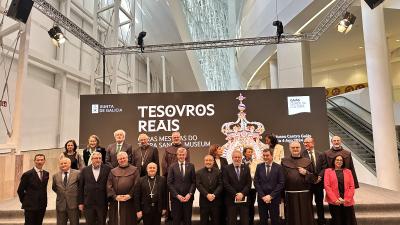
The Terra Santa School for Girls, or TSG, is located on a small street, Saint George Street, close to the Jaffa Gate. The school is Franciscan but it is led by an order whose founder, St. Emily de Vialar, said: “Go with what you have, and what you will receive, and do all the good you can do.” Yes, you guessed it, they are the Sisters of Saint Joseph of the Apparition.
“We arrived in Palestine in 1848 responding to the Franciscan Fathers' call,” said Sister Frida Nasser, the school principal. The Latin Patriarch had also just arrived, and the mission assigned to them was to support the Christian girls of the Old City of Jerusalem. Simple? Not quite. The sisters taught Arabic and French, as well as sewing and embroidery. “At the beginning, the sisters had thirty girls, there not yet any classification by age or level”
Handwritten documents that the sisters have in their archives take us back in time. They are witnesses to the religious wealth that the school was able to guard during the Ottoman occupation, difficult period for the local population. “Thanks to the archives, we know that there were, in addition to the Latin Catholics, also Armenian students and even some Turks. We had students from all religious communities. “These pages carefully, by year, age and section, showed the names—written in calligraphy—of different origins, as well as the teachers' names, their role and their course details.
Today four sisters work at the school. Sister Theresa is in charge of French and of preparing students for the DELF (the Diploma in French language studies). Sister Mariam supervises teachers and teaches catechism along with Sister Nabiha. Sister Frida, the school principal. “Our congregation is leading the establishment but we are under the overall direction of the Franciscans, as are all of the Terra Sancta Schools in the Holy Land.”
The school enrolls girls between four and 16 years of age. “Our girls complete their 11th and 12th grades at the Terra Sancta School for Boys, just a few steps away from here. But this year, for the first time, we have opened 11th grade section.”
The sisters have a special vocation to be in the service of the girls. “The primary purpose of our schools is their moral, scientific and spiritual education. Girls are future mothers, and if they receive a good education, they will have a good family. Moral and spiritual education is so important,” she continued, “but their scientific education is not any less important.”
“We follow the Palestinian educational system,” said the sister. “For the teaching of English and French, we have the freedom to choose the system that suits us best. Our girls take the French DELF exams, at the A1, A2, and B1 levels. Starting at the age of 10, the girls learn Hebrew.”
In the courtyard, enjoying the sunlight that comes in and warms up the cobblestones, the students sit in circles on the ground as they review the day's lessons. The girls sit in the shade under a blue sky, and they jump, run and walk in groups with intertwined hands, ignoring the busy square and the rays that bring warmth. The area of the school, which looks small at first glance, brings encouragement to students in a family-like atmosphere. The school is built around an inner courtyard that has changed very little, or not at all since the first sisters arrived. Amber and black archived monochrome photographs seem to freeze the school in time. These images are used to compare both the elegant hats that students wore as well as their apparent discipline, something that was made obvious by the angle chosen by the photographer. “It is true that we have an average of 25 students per class, but our effort is to treat everything in a case-by-case manner,” she said while turning the pages of the album. “It is important to pay special attention to each student.”
According to the sister, a native of Bethlehem, religious education is different in Jerusalem. “If we take the example of Bethlehem, by comparison there is a family commitment on Sunday mass. In Jerusalem, it is very rare to see it, and the family and family relationships crumble, are crumbing,” the sister said softly. “We feel in the catechism classes that they are detached from the religious reality and with this detachment, there is a disregard for the city and its holy sites. “This is due in part to the cost of living which never ceases to rise. Parents must increasingly work to support the needs of children. Therefore, less time is devoted to children, family or spiritual life.”
The sisters want to continue to raise the education level of the girls and foster their thirst for knowledge. “Our educational objectives have not changed since we first came to Jerusalem: raising the girls through education and passing on knowledge, as well as by strengthening their knowledge of science, culture and faith. A student who acquires this power can go anywhere. The goal has not changed but it has evolved,” she said, “because the challenge is to move with the times while holding on to the principles that we wish to convey. Science is important, but the value of man does not lie in his titles but in his values. We adapt so as to pass on these human values.”




